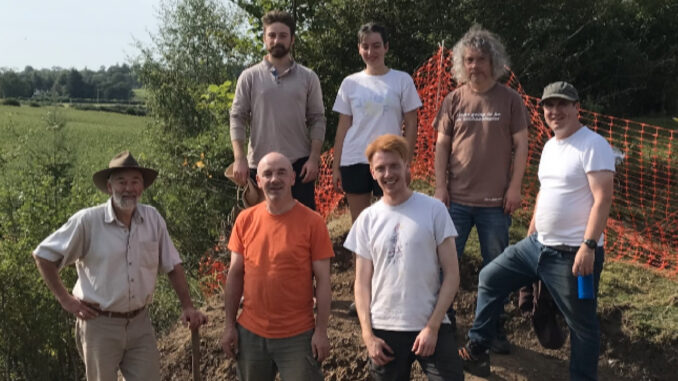
With permission from Historic England a team of local volunteers from English Heritage and Oswestry Heritage Gateway (OHG) have just completed a week long dig at Old Oswestry. The Iron Age hillfort, which lies just north of the town, was last excavated over 80 years ago, so this was an exciting opportunity to get involved and learn something new about this iconic archaeological site.
Under the leadership of local archaeologist Tim Malim of Hampton Heritage Design & Consultancy Ltd, the team cut two trenches across the top and bottom ramparts to investigate how they had been constructed and to take samples for scientific dating which is being undertaken by the University of Oxford’s Research Laboratory for Archaeology & the History of Art.
The higher rampart has not survived to a great height and is now used as a footpath around the interior, but the team found that it had been constructed with a stone revetment wall on the inside and with a stone facing to the outside, with clay and stones compacted into a hard core in the centre. The structure had been infilled and the back wall covered over by a solid mixture of stone and clay making a bank 5m in width but of unknown height.
The lower rampart was built in a very different way, consisting of dumps of clay and stone to make a single large bank 4m wide and 1.5m high. A double line of stones with a gap between them was found to the rear of the bank which may have formed a back edge, perhaps with timber uprights wedged between the stone rows. Although very steep at the front, the Iron Age engineers must have understood the optimum slope to avoid the bank slipping down into the ditch below.
Geophysical prospection is also being conducted over the interior of the hillfort by Archaeological Survey West. The results are looking very promising, with probable roundhouses and their ditched boundary plots showing, as well as other structures and historic ploughing. A possible oven has been detected, close to the location where a bronze working crucible was found in the 1939-40 excavations. Air photographs and an aerial photogrammetric survey and 3D model have been previously undertaken for OHG, and although these show the condition of the monument today, the buried historic details they reveal appear to be from the World War One practice trenches which were excavated by soldiers training for the front whilst based at Park Hall.
Although it will be some months before analysis provides us with dates for the ramparts, the details from the geophysical survey is already giving a good insight into how the interior might have been used during the Iron Age. It also gives a plan on which future investigation can be targeted. OHG volunteers will be continuing to work with English Heritage to manage the site over the coming year, and the introduction of a flock of Soay-Hebridean sheep to the southern ramparts is helping to keep the scrub vegetation under better control.
Oswestry Heritage Gateway (OHG) seeks to harness nationally important historical and cultural
assets as a catalyst for new tourism and economic opportunities for the town and surrounding settlements. The OHG embraces a multi-phase archaeological landscape from Brogyntyn to Whittington as one of outstanding tourism and environmental value, as well as having significant potential to provide recreational, sustainable transport and community benefits.
The strategic management of this history-steeped landscape and environmentally important resource would benefit the quality of life and economy of local communities for present and future generations. Ultimately, the OHG group seeks to partner with stakeholders to further develop the account of one of Britain’s most important hillforts, ‘The Stonehenge of the Iron Age’, which lies at its hub, and foster national and international recognition for this heritage jewel.
The excavation team: (front) Tim Malim, Dave Matthews, Robin Edwards, with Hugo Malim, Meg
Elliott, Neil Phillips and Mark Swain (behind)
Leave a Reply